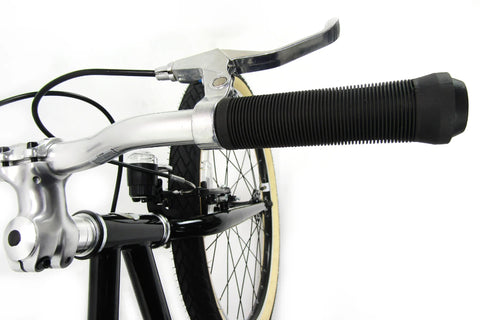What Makes a BMX Different from a Regular Bike?
If you’re new to bikes, you may have wondered what sets a BXM apart from regular bicycles. Would it be worthwhile to invest in one, or should you go for a standard model first? Understanding the nuances between these two is key to making an informed choice.
In this blog, we will delve into the characteristics that define BMX bikes - what this acronym stands for. Read on and learn the specialised frame designs and adrenaline-pumping tricks they enable!
Purpose of BMX Bikes

(Image Credit: Wallpaper Flare)
BMX, short for Bicycle Motocross, is a specialised category of bikes designed for: 1.) extreme sports and 2.) stunt riding. Unlike regular bikes, like city bikes, BMX bikes boast a distinctive frame geometry. This component features smaller frames, shorter wheelbases, and robust construction. Together, they make up for the model’s ability to withstand the rigours of tricks and jumps. Primarily engineered for agility and manoeuvrability, BMX bikes excel in:
- skate parks
- dirt tracks
- urban landscapes
The primary purpose of BMX bikes revolves around performing gravity-defying stunts. This showcases precision and fosters a culture deeply rooted in youth and sports. In contrast, regular bikes cater to a broader spectrum of uses. This includes commuting, recreational cycling, and long-distance riding. Overall, it emphasises comfort and efficiency over the specialised demands of extreme sports.
Frame and Design
The frame design of Kids BMX bikes sets them apart with a focus on durability and manoeuvrability. When it comes to the design, it’s typically smaller and more compact. Moreover, it features reinforced tubing to withstand the impact of jumps and tricks. The reduced size enhances the bike’s agility. This allows riders to perform intricate manoeuvres effortlessly.
In terms of materials, BMX frames often incorporate robust alloys or chromoly steel. Both offer added strength without compromising weight. Additionally, the geometry differs, with steeper head tube angles and shorter wheelbases. These designs contribute to quicker handling and responsiveness of a BMX bike.
In contrast, regular bike frames prioritise comfort and efficiency. In most cases, they feature longer wheelbases and relaxed angles. These, in turn, guarantee a smoother ride during extended periods.
Recognising these subtle design differences reveals why BMX bikes excel in their field. Overall, they prioritise strength and precision over the broader uses of regular bicycles.
Components and Features
Breaking down BMX bike components reveals a focus on functionality and resilience. Starting with the handlebars, which are often shorter for precise control. Next, the wheels are compact, enhancing manoeuvrability. Tires designed for varied terrains provide optimal grip during stunts.
In contrast, regular bikes prioritise comfort and efficiency. Handlebars are typically longer, offering a relaxed riding position. The larger wheels contribute to stability during longer rides. The tires cater to diverse surfaces, aiming for a smooth and comfortable experience. Understanding these component distinctions shows BMX bikes are tailored for specialised, high-performance activities. Meanwhile, regular bikes prioritise versatility for everyday use and varied terrains.
Riding Styles
When talking about riding styles, BMX bikes are designed for the adrenaline-fueled of:
- street
- park
- dirt
In street BMX, riders navigate urban landscapes, executing tricks on ramps and rails. Park BMX involves showcasing skills in purpose-built skate parks. Meanwhile, dirt BMX enthusiasts conquer off-road trails and jumps.
This versatility contrasts sharply with the diverse riding styles of regular bikes. Regular bikes excel in practical commuting, where comfort and efficiency are paramount. Road cycling emphasises speed and endurance on paved routes. Whereas mountain biking tackles rough terrains. The contrast in riding styles underscores how BMX serves the thrill-seeking. And regular bikes cater to a spectrum of everyday needs and varied terrains.
Manoeuvrability and Tricks

BMX bikes are crafted with a focus on agility and trick performance. Their design allows riders to navigate tight spaces and perform tricks with precision. The geometry promotes quick turns and responsive handling.
In contrast, regular bikes face limitations in manoeuvrability. For one, due to longer wheelbases and frames optimised for stability and comfort. While excellent for commuting and longer rides, they may be less agile in executing sharp turns and complex tricks. Simply put, BMX bikes are made for riders who want to be highly agile and enjoy the excitement of doing tricks.
Terrain Considerations
BMX bikes thrive on diverse terrains. They excel in environments like skate parks, urban streets, and dirt trails. Their robust design, responsive handling, and sturdy tires, makes them well-suited for challenging dynamic settings. BMX riders can seamlessly transition between ramps, rails, and jumps. This showcases the bikes’ adaptability to different landscapes.
In contrast, regular bikes exhibit impressive adaptability across various terrains. This includes roads, mountain trails, and city streets. They offer riders the flexibility to navigate different landscapes comfortably. All thanks to the features they come equipped with, such as versatile tire treads and frames.
Pros and Cons
Now, let’s take a closer look at the advantages and disadvantages of choosing a BMX bike. Understanding the strengths and limitations of BMX bikes is essential. This will help you make an informed decision based on your needs and preferences.
Advantages
BMX bikes excel in agility. They’re ideal for tricks and stunts in dynamic environments like skate parks and dirt trails. Their sturdy construction and specialised design set them apart. These features especially cater to thrill-seekers who crave precision and manoeuvrability. But, as mentioned, some limitations come with these benefits.
Disadvantages
BMX bikes may lack the comfort and efficiency needed for longer rides or varied terrains. Regular bikes, with their diverse styles and designs, might be a better choice. This is especially the case for those prioritising practicality, comfort, and versatility.
Round-up
So, which do you prefer? The excitement of BMX tricks of the practicality of regular biking? Either way, understanding these differences is crucial. BMX bikes prioritise precision and agility. Meanwhile, regular models offer comfort and adaptability on different terrains. Ultimately, the choice boils down to your needs and the kind of riding experience you enjoy. But when it comes to an exhilarating cycling journey, you can never go wrong with BMX bikes!
Discover a diverse selection of bicycles at Bobbin, catering to both kids and adults. Explore our latest additions, including the Arcade 20 and Shadowplay Junior models.
Up next on your reading list: How to Do Easy BMX Tricks for Kids










